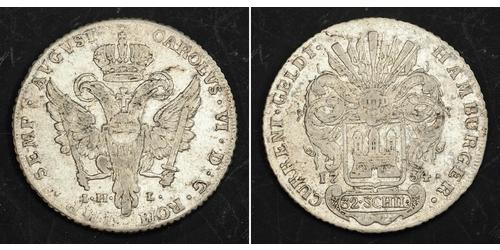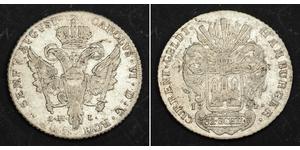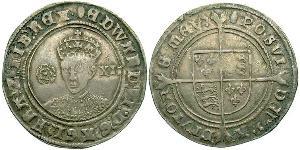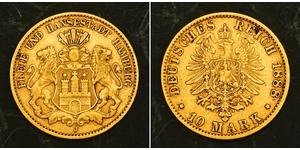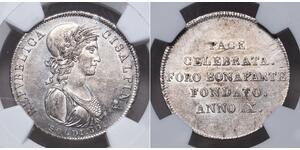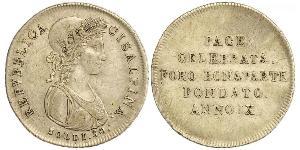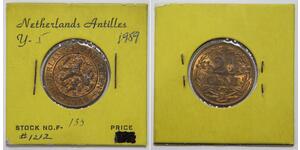2 Mark / 32 Shilling Hamburg Silver Charles VI, Holy Roman Empero ...
1734, Hamburg (Free City), Charles VI. Silver 2 Mark (32 Shilling) Coin. aXF!
Mint Year: 1734 Reference: KM-384. Denomination: 2 Mark (32 Schilling Mint Master: Johann Heinrich Löwe (IHL) Mint Place: Hamburg (Free Hanseatic City) Condition: Scattered contact-marks from circulation, otherwise about XF! Weight: 18.09gm Diameter: 39mm Material: Silver
Obverse: Imperial crown above double-headed eagle with cross-topped orb at chest, holding scepter and sword in claws. Mint director´s initials (I.H.-L.) split in fields below. Legend: CAROLVS . VI . D . G . ROM – IMP . SEMP . AVGVST . Reverse:Plummetted helmet adorned by six flags topping shield with coat-of-arms Hamburg (castle with three towers and open gate). Value in shillings (32. SCHIL.) in table bolow, date (17-35.) split in fields at sides. Legend: HAMBURGER . (32 . SCHIL .) CURRENT . GELDT
Upon the dissolution of the Holy Roman Empire in 1806, the Free Imperial City of Hamburg was not mediatised but became a sovereign state officially titled Free and Hanseatic City of Hamburg. Hamburg was briefly annexed by Napoleon I to the First French Empire (1810–14). Russian forces under General Bennigsen finally freed the city in 1814. Hamburg reassumed its pre-1811 status as city-state in 1814. The Vienna Congress of 1815 confirmed Hamburg’s independence and it became one of 39 sovereign states of the German Confederation (1815–66).
Charles VI (German Karl VI) (October 1, 1685 – October 20, 1738) was Holy Roman Emperor, King of Bohemia (as Karel II.) and Hungary (as Károly III.) from 1711 to 1738. From 1703 to 1711 he was an active claimant to the throne of Spain as Charles III.
Charles was born in Vienna, the second son of the Emperor Leopold I and of his third wife, Princess Eleonore-Magdalena of Palatine-Neuburg. He was given the baptismal names Karl Franz Joseph Wenceslau Balthasar Johann Anton Ignatius. His tutor was Prince Anton Florian of Liechtenstein.
Charles was the contracted heir of the Spanish Habsburgs. When Charles II of Spain made Philip V his heir, Louis XIV violated the contract. The dispute for the crown of Spain led to the War of the Spanish Succession.
After his older brother the Emperor Joseph I died suddenly in 1711, Charles returned to Austria. He succeeded immediately as King of Hungary and King of Bohemia. Later that year he was elected Holy Roman Emperor in Frankfurt.
Although Charles seems to have been clumsy in political affairs, the Austrian monarchy reached its widest expansion during his reign. His superior army was defeated by Bosnians in year 1737 in Battle of Banja Luka.
He married Elisabeth, eldest daughter of Louis Rudolph, Duke of Brunswick-Lüneburg. At the time of his death, his only surviving children were Maria Theresa and Maria Anna, so he had no living male heirs – a situation he had guarded against in the Pragmatic Sanction of 1713, which stated that his realm could not be divided and allowed that daughters also could inherit the throne from their fathers. When he died, the War of the Austrian Succession took place, but in the end the Pragmatic Sanction held up and his daughter succeeded him as Queen of Hungary and Bohemia and Archduchess of Austria. However, being a female, she was not elected Holy Roman Empress. Instead, Charles VII was elected. However, after Charles VII’s reign, Maria Theresa’s husband Francis III Stephen, Duke of Lorraine, was elected, ensuring that the Empire would continue in the Habsburg line.
Probably as a consequence of his years in Spain, he introduced the Spanish court ceremonial (Spanisches Hofzeremoniell) in Vienna and built the Spanish Riding School. Furthermore, the Reichskanzlei (“chancellory of the state”) and the National Library were constructed during his reign and the Michaeler tract added to the Hofburg. Much was designed in baroque style in Vienna during Charles' reign.
He also had musical ambitions. Taught as a boy by Johann Joseph Fux, he composed, played the harpsichord, and now and then conducted the court’s band.
There is some evidence that Charles' death was caused by consuming a meal of death cap mushrooms.
Karl succeeded more as a musician than as a statesman. He composed, played the harpsichord, and conducted the court band. Unfortunately, he performed those functions when he should have been leading the nation.
(1365 X 646 pixels, file size: ~195K)
Posted by: anonymous 2018-05-10
1734, Hamburg (Free City), Charles VI. Silver 2 Mark (32 Shilling) Coin. aXF! Mint Year: 1734 Reference: KM-384. Denomination: 2 Mark (32 Schilling Mint Master: Johann Heinrich Löwe (IHL) Mint Place: Hamburg (Free Hanseatic City) Condition: Scattered contact-marks from circulation, oth ...
30 Soldo Italy
group has 14 coins / 13 prices
⇑
2 1/2 Cent Netherlands
group has 18 coins / 14 prices
⇑

